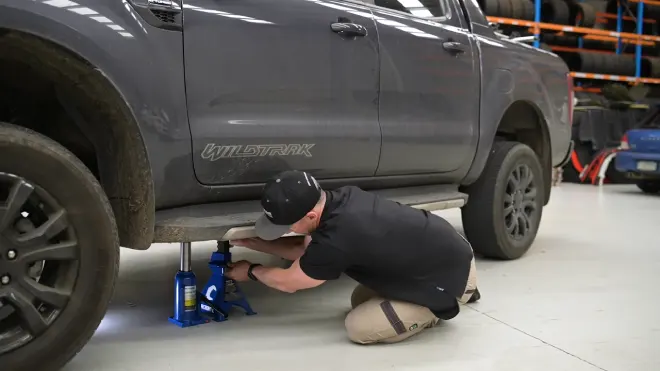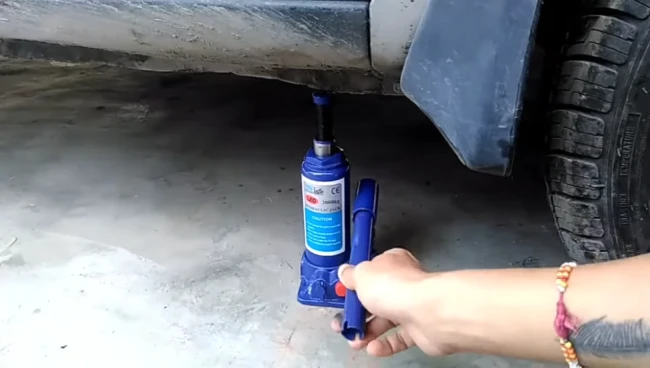Last Updated on May 29, 2023
Safety becomes a top concern when making car repairs. One common question that mechanics and car owners alike often ask is whether or not a bottle jack can lift a car.
You can use a bottle jack to lift a car cautiously, but you should be aware of its limitations and guidelines before doing so. Knowing how to use a bottle jack correctly lets you safely and effectively lift your car for any necessary repairs.
We will dive into everything you need to know about bottle jacks, their limitations, and proper utilization techniques.
How Can You Use a Bottle Jack To Lift A Car: Steps with Precautions

Step 1: Prepare for the lifting process
Step 2: Inspect and Prepare the Jack
Step 3: Locate the Designated Lift Point
Step 4: Position the Jack Under the Lift Point
Step 5: Lift the Vehicle to the Desired Height
Step 6: Safely lower the vehicle and clean up
Bottle jacks, for instance, could be an excellent option for lifting cars. However, there are significant safety concerns you must bear in mind before deploying one. Use a bottle jack safely and effectively by following these steps.
Step 1: Prepare for the lifting process
In order to prevent unintended movement, park the vehicle on a level surface, preferably in a garage, and engage the parking brake before lifting. This crucial step ensures that the jack will be stable during use and prevents accidents or damage to your vehicle.
To further ensure safety, follow these additional steps before using a bottle jack:
- Place wheel chocks behind both tires on the opposite end of the car from where you plan to lift.
- Turn off the engine and remove the keys from the ignition.
- Wear protective gear such as gloves and safety glasses.
Step 2: Inspect and Prepare the Jack
The jack must be thoroughly inspected and prepared before the lift begins to ensure its proper functioning and avoid any safety issues. In this process, check for any flaws, damage or leaks in hydraulic oil.
Any imperfections can potentially cause accidents or lead to a jack malfunction during lifting, which can be dangerous. Ensures the plug is tightly secured and the release valve is closed.
A loose plug or an open release valve can result in instability while lifting the car, leading to a loss of balance and accidents.
Additionally, wiping debris off the saddle helps ensure proper contact between it and the vehicle, enabling efficient lifting without any slippage. Assembling and inserting the handle securely into the jack also plays a significant role in preventing any mishaps while using it.
Step 3: Locate the Designated Lift Point
Identifying the designated lift points of a vehicle is a crucial step in initiating safe and efficient lifting. These points are specifically designed to support the car’s weight without causing damage, making them essential for proper lifting procedures.
You should refer to the owner’s manual or manufacturer’s guidelines to locate these points. It is important to note that lift points can vary between vehicles, so it is necessary to double-check before proceeding.
Step 4: Position the Jack Under the Lift Point
When positioning the jack under the lift point, align the saddle with the lift point and slowly raise it until it touches, ensuring it’s stable and centered. This step is crucial to ensure the vehicle remains stable while lifting.
Here are some tips to help you position your bottle jack safely:
- Always use a solid board if needed: If you’re working on an uneven or soft surface, using a solid board can create a stable and level surface for your bottle jack.
- Place the bottle jack as close as possible to the designated lift point: This helps prevent any unnecessary tilting or sliding while lifting.
- Check for defects before use: Before positioning your bottle jack, always check for any visible signs of damage or defects that could affect its stability.
- Ensure readiness before use: Ensure all necessary tools and equipment are within reach before positioning your bottle jack.
Step 5: Lift the Vehicle to the Desired Height
Raising the vehicle to the desired height can be critical in performing any maintenance or repair work. It requires careful attention and precision, as any sudden movements or miscalculations could result in catastrophic consequences.
Once you have positioned the jack stand(s), start pumping the bottle jack slowly until the vehicle is lifted to your desired height. While raising, keep an eye on both sides of the car to ensure that it lifts evenly. If you notice any imbalance, stop immediately and adjust before proceeding.
Step 6: Safely Lower the Vehicle and Clean up
After maintenance or repairs, lowering the vehicle and cleaning it up is vital work that requires careful attention to safety. It is essential to remove the jack stands before lowering the vehicle onto the ground slowly.
Double-check that no one is working under or near the car, as it could be hazardous to their safety.
What is the strength of bottle jacks?

Bottle jacks wield different strengths, contingent upon their maximum weight capacity. Robust models are capable of bearing burdens of up to 30 tonnes. These streamlined tools are expertly used to lift objects with precision and safety, making them a prime choice for household or mobile use.
With a range of maximum weight capacities available, users can choose the right bottle jack for their specific needs.
When selecting a bottle jack for lifting a car, it is important to ensure that the jack’s maximum weight capacity is sufficient for lifting the vehicle. A bottle jack with a lower maximum weight capacity may suit smaller cars. Larger vehicles will require a bottle jack that can handle greater loads.
What is the maximum lift height of a bottle jack?
The lift height of a bottle jack is determined by its stroke, which typically ranges from 9 to 18 inches and dictates the distance the tool can raise an object. The stroke refers to the piston’s length inside the cylinder when pumping up. Generally, a longer stroke will result in a higher lifting capacity for the tool.
However, you need to note that using a bottle jack at its maximum height may not be safe or recommended. To ensure proper usage of a bottle jack, you must consider factors such as weight distribution and load capacity.
Before attempting any lifts, checking if your car’s weight exceeds your chosen jack’s lifting capacity is crucial. Also, it is advisable to use appropriate support stands once you have raised your vehicle with a bottle jack.
Are two-ton bottle jacks capable of lifting cars?
A 2-ton bottle jack can lift most cars provided that it meets the weight requirement specified on the driver’s side door jam sticker. However, investing in a jack with more capability is a wise choice. The ideal capacity of a jack should reach about three-quarters of the vehicle’s overall weight to ensure maximum safety.
It is crucial to note that using a jack with a lower capacity than the vehicle’s weight can be hazardous and result in safety risks. Therefore, choosing a jack with a higher weight capacity is advisable for handling unexpected situations.
Follow the manufacturer’s instructions and safety guidelines while using the jack.
When should you not use a bottle jack?

Soft surfaces like sand or gravel and uneven terrain may prove unstable for load-bearing devices with limited weight capacity. This is particularly true for bottle jacks designed to lift loads and not hold them in place. Bottle jacks have a small base area that can easily sink into soft surfaces or tip over uneven ground.
In addition, it is not advisable to use a bottle jack when there is a risk of the load shifting or moving suddenly. When lifting a car with a bottle jack, it is essential to ensure that the vehicle is parked on firm and level ground. If the car moves while being lifted, the jack could topple over or shift, causing serious injuries.
Note: Bottle jacks should only be used if necessary and with extreme caution.
What happens if you overload a bottle jack?
The use of a bottle jack can be convenient when lifting a car. However, there are certain situations when it is not recommended to use one. For example, using a bottle jack can be dangerous if the car is too heavy for the jack or if the surface on which the jack is placed is unstable.
If you overload a bottle jack, something called an overload valve will kick in. This valve acts as a safety mechanism and releases pressure from the system to prevent any further rise of the ram. Essentially, this means that the bottle jack will stop working until some of its load has been removed.
Not all bottle jacks have an overload valve, so check your bottle jack before using it. Overloading a bottle jack can also cause damage to its internal components and affect its overall performance. It may lead to leaks or even complete failure of the tool over time.
Effortlessly Lift Your Car Anywhere with Bottle Jacks
Bottle jacks are a practical and commonly-used tool for lifting cars due to their ease of use and portability. However, it is important to understand the limitations of these jacks before using them for car lifting purposes.
When using a bottle jack, bear in mind its weight capacity and maximum lifting height to avoid overloading it beyond its capabilities. Additionally, using these jacks on even surfaces is crucial to prevent them from becoming unbalanced.
Better safe than sorry, so make sure to use these jacks safely and with care to avoid any potential hazards.

